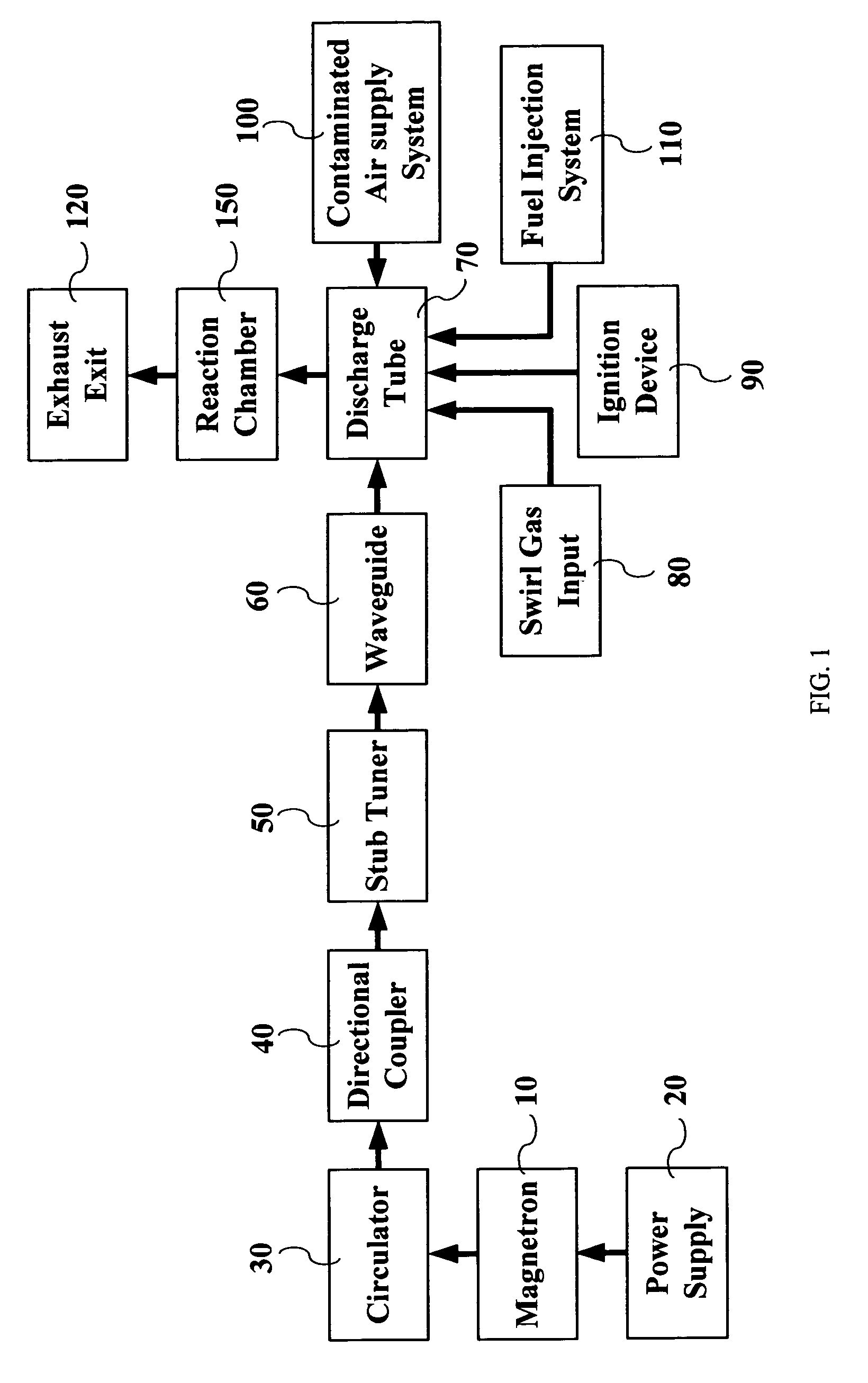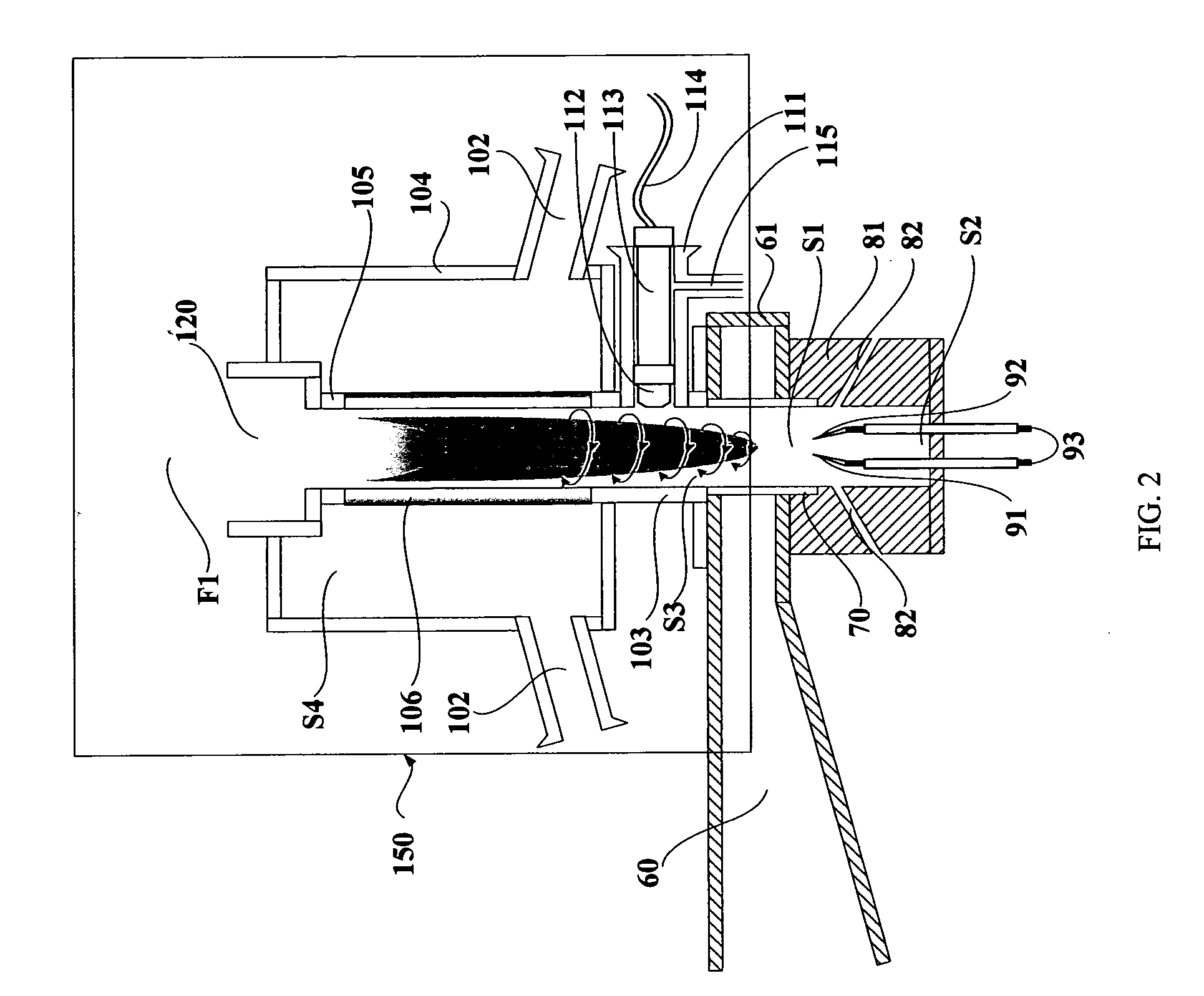Large-volume elimination of airborne chemical and biological warfare agents by making use of a microwave plasma burner
a technology of microwave plasma and chemical warfare agents, applied in the field of large-volume elimination of airborne chemical and biological warfare agents by making use of microwave plasma burners, can solve the problem that the elimination experiment of any chemical warfare agent is almost impossible in an ordinary laboratory, and achieve the effect of efficient chemical reactions
- Summary
- Abstract
- Description
- Claims
- Application Information
AI Technical Summary
Benefits of technology
Problems solved by technology
Method used
Image
Examples
example 1
[0052]As an example, we used toluene as a simulated chemical warfare agent, and kerosene and methane were used as the hydrocarbon fuels in liquid and gaseous states, respectively. Toluene are evaporated into air and a suction fan supplied the contaminated air of R=5,000 liters per minute (lpm) to the reaction chamber 150. 40 lpm of the compressed air was supplied to the swirl gas input 80. The injection rates of the kerosene in this experiment are 1.15 kg / hr, 1.46 kg / hr and 1.87 kg / hr. 1.15 kg / hr is approximately 0.3 gal / hr. The methane flow rates are 5 lpm, 10 lpm, 15 lpm, 20 lpm and 30 lpm. The microwave power was 1.4 kW and the initial toluene concentration was X0=170 particulates per million (ppm). The reaction chamber size was measured to be 22 cm diameter and 30 cm long. The compactness and lightweight of the decontamination apparatus are the key issues for quick and easy application in life-threatening situations. Therefore, the reaction chamber must be as small as possible f...
example 2
[0054]The next example is the decomposition of hydrogen sulfide (H2S). The hydrogen sulfide molecules are mixed in air and a suction fan supplied the contaminated air of R=5,000 liters per minute (lpm) to the reaction chamber 150. 40 plm of compressed air was supplied to the swirl gas input 80. The injection rates of the kerosene in this experiment are 1.15 kg / hr, 1.46 kg / hr and 1.87 kg / hr. The methane flow rates are 5 lpm, 10 lpm, 15 lpm, and 20 lpm. The microwave power was 1.4 kW and the initial hydrogen-sulfide concentration was X0=120 ppm. The reaction chamber size was measured to be 22 cm diameter and 30 cm long. The input lines leading to detection apparatus like GC or FTIR can easily absorb the hydrogen sulfide molecules. It is therefore unreliable to use GC or FTIR for measuring concentration of hydrogen sulfide molecules in air. The decomposition data were measured by making use of detector tubes. FIGS. 9 and 10 are the hydrogen-sulfide decomposition rates in terms of the k...
example 3
[0055]Elimination experiment of the airborne biological warfare agents is very hard because of difficulty of detecting the agents before and after the plasma flame treatment. Spores of the biological warfare agents are usually attached to aerosol particles. Elimination of aerosol particles may indirectly show the elimination of airborne biological warfare agents. Elimination of soot from diesel engine, which can be seen as airborne aerosol particles, was observed in this example. The kerosene burning may generate its own soot, which may interfere the observation of diesel engine soot so that the gaseous fuel of methane was used in the experiment. The methane injection rate was 15 lpm, 25 lpm and 30 lpm. The discharge gas from 10,000 cc bus diesel engine at 800 rpm was used for contaminated air with soot. The airflow rate at the engine exit is 8,000 lpm, which is estimated to be 3,500 lpm at the end of the tail pipe due to cooling of the ambient air. The energy density therefore was ...
PUM
| Property | Measurement | Unit |
|---|---|---|
| frequency | aaaaa | aaaaa |
| height | aaaaa | aaaaa |
| width | aaaaa | aaaaa |
Abstract
Description
Claims
Application Information
 Login to View More
Login to View More - R&D
- Intellectual Property
- Life Sciences
- Materials
- Tech Scout
- Unparalleled Data Quality
- Higher Quality Content
- 60% Fewer Hallucinations
Browse by: Latest US Patents, China's latest patents, Technical Efficacy Thesaurus, Application Domain, Technology Topic, Popular Technical Reports.
© 2025 PatSnap. All rights reserved.Legal|Privacy policy|Modern Slavery Act Transparency Statement|Sitemap|About US| Contact US: help@patsnap.com



